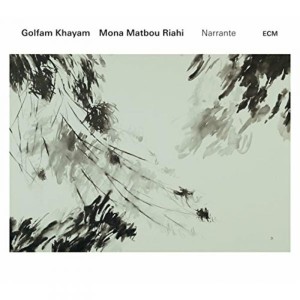 Narrante is an utterly fascinating album, and it’s like very little else that I’ve ever heard. Golfam Khayam and Mona Matbou Riahi, who perform as Naqsh Duo, are Iranian musicians making their debut on the German jazz and classical label ECM. Khayam plays guitar and Riahi clarinet, and their music explores the uncategorizable place where western and eastern traditions meet.
Narrante is an utterly fascinating album, and it’s like very little else that I’ve ever heard. Golfam Khayam and Mona Matbou Riahi, who perform as Naqsh Duo, are Iranian musicians making their debut on the German jazz and classical label ECM. Khayam plays guitar and Riahi clarinet, and their music explores the uncategorizable place where western and eastern traditions meet.
First of all, classical guitar and clarinet is not that common a combination. Both are western instruments, although both have analogs in the music of the Mediterranean and Near East, and probably Persian music as well. (It’s one of the sad facts of the now nearly 40-year-old lack of contact between Iran and much of the west that those of us on both sides who have lived through this cultural embargo know very little about each other. Particularly each other’s contemporary cultures.)
And second, these two are combining Persian and western musical traditions in unusual ways. Their music to my ears sounds like it draws heavily from Andalusian traditions, Spanish classical guitar and the like, with other influences from contemporary classical and avant-garde styles. These they interpret through a mix of composed and improvised approaches, the former western and the latter from their native Persian tradition.
Guitarist Khayam says the nine pieces here have an invisible thread running through them, and constitute “a very personal glance at the roots of Persian music. … It’s not ‘traditional’ anymore; it’s no longer from that zone. The freshness and purpose of improvisation come mostly from the Persian side, while the careful structure and careful crafting come from Western contemporary music. We take these elements and try and figure out a formal structure or find a frame or plot which we can craft them into. Some of the pieces have open sections for improvisation and some are completely pre-composed yet sound improvised.”
The pieces all have titles in Italian, a reflection of the fact that the two met in Lugano and recorded the album there in the summer of 2015.
Khayam and Rhiahi both have what sounds to me like impeccable technique, which produces tones of liminal quality. Riahi’s clarinet tone is never less than pristine, and Khayam’s playing betrays obvious classical training. You never hear her fingers squeak on the strings unless she wants you to. That said, both frequently push their instruments beyond traditional sounds and techniques of East or West. The opening track “Testamento” begins with Riahi playing two horns simultaneously, one a half-clarinet played as a drone. After her short solo section, Khayam’s guitar enters with an Andalusian-style melody, with Riahi adding color with long clarinet phrases.
Here is a performance video of “Testamento.”
The most striking piece is “Battaglia,” a vivid exploration of the limits of the instruments’ capabilities, and of their own abilities to improvise within the duo setting. The title of course means “battle,” and at times Khayam seems to be doing battle with her guitar, beating on its top and strings with her hands and mallets. This one is very much within the realm of contemporary western classical music. The following piece, “Parlando,” is by contrast something of a love song for clarinet and guitar, an explicit conversation between the two instruments, each embellishing on the other’s phrases and sounds and playing some lovely unison passages. “Narrante,” the title track, finds Khayam providing a western-style classical guitar free-form introduction, followed by a melodic section with pastoral motifs; the clarinet when it does enter at about 1:20 introduces dissonance that pastoral setting.
The most beautiful, perhaps, is “Sospiro,” which means to sigh, and also is the name of an ancient town in Cremona. The guitar plucks figures that call to mind Spanish classical playing, as the clarinet sighs out a subtly Oriental melody. After a while they stray into modernist form, the clarinet exploring its range and a variety of non-standard buzzes, trills, extremes of dynamics loud to soft, the two seemingly egging each other on to further improvisations, although that, as Khayam pointed out in the quote above, may be an illusion.
This unusual music is beautifully recorded with ECM’s trademark spacious sound. These two instruments make each other vibrate in unusual and colorful ways. Adventurous listeners will find much to captivate them here.
(ECM, 2016)
